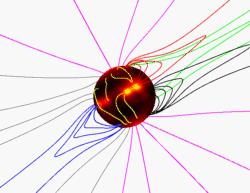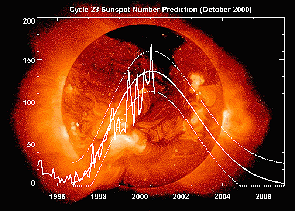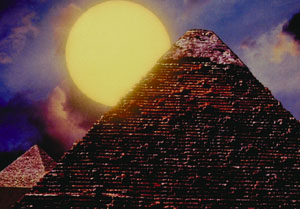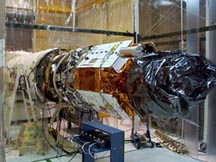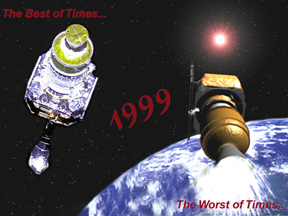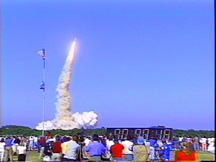The Ulysses Mission
News story originally written on June 30, 1997
"..Come, my friends, tis not too late to seek a newer world."-Tennyson in "Ulysses" The Ulysses Mission is indeed seeking a newer world, a world that is encompassed by our Sun. Ulysses is a space mission designed to explore the unknown region of space above the poles of the Sun. It is the first spacecraft to explore space at high solar latitudes. Ulysses is a joint endeavor of the European Space Agency (ESA) and the National Aeronautics and Space Administration (NASA). The ESA provided the spacecraft and the operations team for the spacecraft. NASA launched the spacecraft on the Shuttle Discovery in October 1990. NASA is also responsible for radio communications and data management for the overall mission.
The Ulysses spacecraft flew by Jupiter in February 1992, for the gravity assist needed to place the spacecraft into its solar polar orbit. This high-latitude orbit allowed Ulysses to fly over the south pole of the Sun in 1994 and over the north pole in 1995.
The primary scientific objective of the Ulysses mission is to characterize the fields and particles of the Sun in relation to latitude, with particular emphasis on the regions above the poles. So Ulysses has been and will be investigating the solar magnetic field, solar wind plasma, and galactic cosmic rays coming from the Sun. Its instruments are geared toward studying these particular solar topics.
The phenomena being studied by the Ulysses mission are strongly influenced by the 11 year solar cycle. The primary mission which ended in September 1995, extended over half of the solar cycle. The secondary mission (or second pass around the Sun) makes coverage of the second half of a cycle possible. It is here at solar maximum that Ulysses will encounter solar flares, coronal mass ejections, and high-latitude streamers.
The Ulysses mission has already made many new findings concerning our knowledge of the Sun. For instance, our prior knowledge of the Sun suggested that the Sun had a dipolar magnetic field. In the dipolar model, field lines form closed loops except at the poles, where field lines are open and extend far into interplanetary space. Also in this model we know that field strength at the poles is twice that at the equator. But Ulysses has found that the dipolar model does not hold for the Sun. It seems that the magnetic field strength or flux is similar regardless of latitude. It is thought that immense pressure forces of the Sun take part to equally distirbute the solar magnetic flux.
The Ulysses mission is also participating in the GRB (Gamma Ray Bursts) study. Twice a day the Earth is blasted by pulses of gamma-rays. Since their discovery about 20 years ago, there have been over 100 suggested theories to explain these gamma-rays and their source. Ulysses stands as one component in an interplanetary network set up to trace the gamma-ray bursts. The network includes the Pioneer Venus Orbiter, the Compton Gamma-Ray Observatory spacecraft, Russia's GRANAT mission, the Japanese Yohkoh satellite, and the Indian SROSS-C mission. Ulysses' unique trajectory around the Sun will only aid in tracing the gamma-ray bursts with further accuracy.
With the first phase of its mission successfully completed, Ulysses is now in its second orbit of the Sun. This secondary phase will be finished in December 2001.






